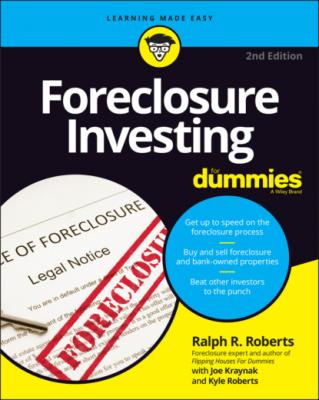Foreclosure Investing For Dummies. Ralph R. Roberts
Чтение книги онлайн.
Читать онлайн книгу Foreclosure Investing For Dummies - Ralph R. Roberts страница 14
 message on your forehead: My eyes, or no buys. You can look at the title work and other property documents until your eyes cross, but you don’t know the condition of the property unless you see it for yourself. I recommend that you do the following:
message on your forehead: My eyes, or no buys. You can look at the title work and other property documents until your eyes cross, but you don’t know the condition of the property unless you see it for yourself. I recommend that you do the following:
Visit the property and the neighborhood it’s in. Never try to assess the value of a property in a vacuum. The condition of the neighborhood affects the sale price.
Walk around the property and inspect it from all four sides. The front of the house can look like the Taj Mahal while the back or sides look more like a bombed-out bunker. See Chapter 8 for additional suggestions on doing drive-by and walk-around inspections.
If possible, get inside and look around. You don’t want to get arrested for trespassing or run off by an angry homeowner, but if the homeowner invites you in, accept the invitation.
See Chapter 8 for more tips on inspecting the property with your own two eyes.
Guesstimating a property's true value
An essential component of successful real estate investing is developing an exit strategy or endgame. Before you agree to pay a certain price for a property, you must have a fairly accurate estimate of what you can sell it for. Otherwise, you risk overpaying and losing money on your investment.
Estimating the market value of a house is easiest with the assistance of a real estate agent who’s knowledgeable about property values in the area. A qualified agent can pull up Multiple Listing Service (MLS) sheets on comparable homes that have recently sold in the same neighborhood and quickly provide you a good idea of how much you can sell the property for, assuming that it’s in marketable condition and the market remains relatively stable.
Don’t let your agent or the word on the street pump up your expectations or estimates. Tell your agent that you want an estimated sales price based on reality, not hope. Provide your agent as many details as possible about the property to ensure that the estimate is based on truly comparable properties.
Investigating the situation and the homeowners
The more you know about the homeowners and their situation, the better able you are to assist them in extricating themselves from their current predicament. Unfortunately, homeowners who are facing foreclosure often feel isolated, ashamed, resentful, and defensive. They may not be very forthcoming about the details that landed them in their current situation, and they may see you as merely an opportunist who’s trying to sell their property out from under them.
In a way, they’re right. You do want the property, and you want to make a profit. But that doesn’t change the fact that the homeowners are trapped and need to explore their options. Your job at this stage is to convince the homeowners that they’ll see better results working with you than with someone who’s not quite on the level. In Chapter 9, I show you how to approach distressed homeowners and explain their options.
When you meet with homeowners, listen at least twice as much as you talk, and try to gather the information like the following that can enable you to provide more valuable guidance and assistance:
The total amount owed on the first mortgage and all other liens on the property, including any back taxes owed
The current monthly payment on the house and on any other outstanding loans
The names and contact information for all lienholders (lenders, contractors, and others who have a claim on the property)
The amount of time before the property goes up for auction
The value of any possessions the homeowners have that can be liquidated
A list of any family members who may be able to help
A clear idea of what the homeowners see as their options, such as selling the house, moving to a rental unit, relocating, or scaling down to a smaller house
This brief list can start you on your information-gathering mission, but as you talk with the homeowners, other issues and opportunities often present themselves. Create a thorough record of your discussions with the homeowners so that you can begin to paint a portrait of them in your mind. The more information you have, the more creative you can be in developing viable solutions. See Chapter 9 for additional details.
Setting and Sticking To Your Maximum Bid
Even the coldest and most calculating real estate investors become enthusiastic about properties. They may fall in love with a particular house or simply get so caught up in the heat of an auction that they bid too much for a property. Then they have to work twice as hard to make a profit on it.
In Chapter 10, I show you how to set the maximum price you’ll pay for a property when preparing an offer to purchase directly from homeowners. In Chapter 11, I lead you through the process of preparing a maximum bid for an auction and let you in on some strategies for effective bidding.